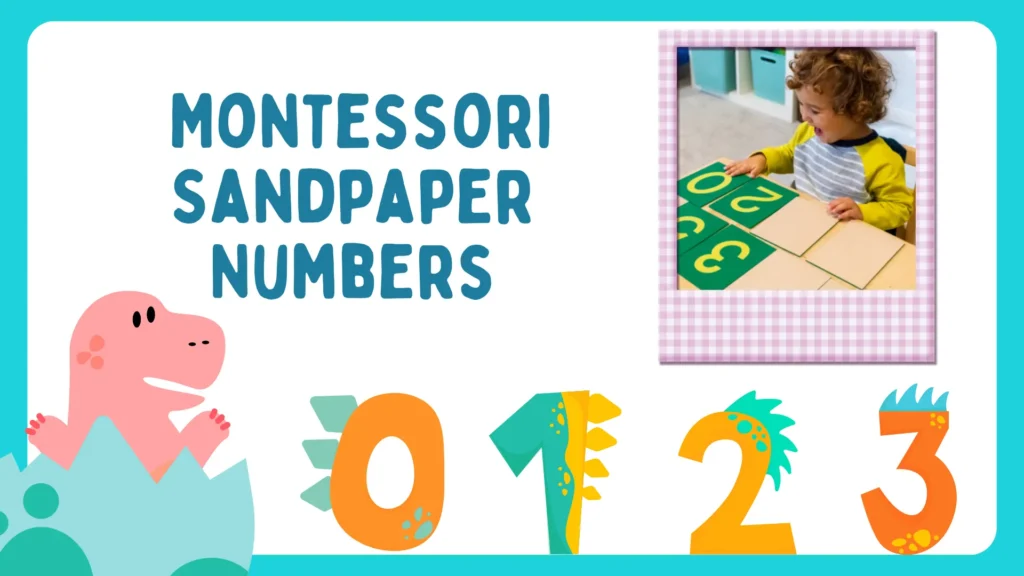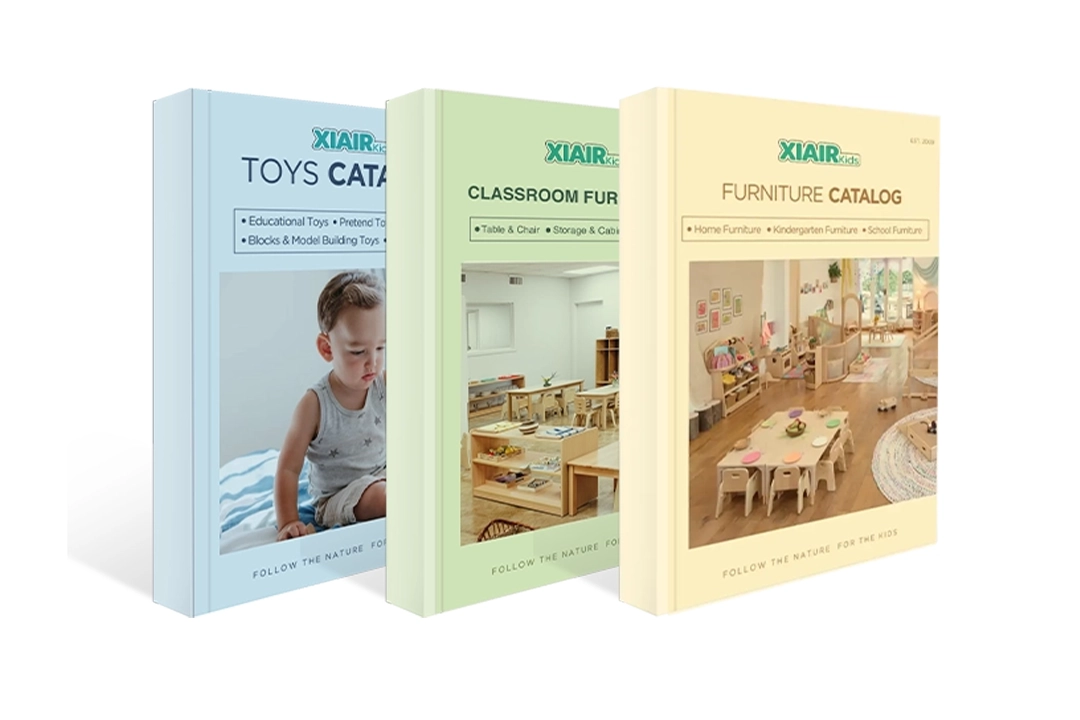In Montessori education, children begin learning mathematics through their senses, especially touch. Before they work with abstract symbols or written numbers, they are introduced to materials they can feel and trace with their hands. This tactile experience helps them form a clear, lasting impression of numerical shapes long before they start counting or writing. Through touch, movement, and repetition, mathematical learning becomes concrete and meaningful from the very beginning.
Among the first tactile math tools is the set of Montessori Sandpaper Numbers. Each numeral from zero to nine is cut from textured sandpaper and mounted on a smooth green board. Children trace each number with their fingers while saying its name aloud, connecting the sense of touch with sound and sight. These sandpaper numerals Montessori cards serve as a bridge between sensorial exploration and the understanding of numerical symbols, preparing children for later work with counting materials like Montessori number beads and Montessori number roll paper.
In this article, I will show you how children learn to recognize and name the numbers from one to ten using Montessori Sandpaper Numbers. You will discover how to use these materials effectively and how to create your own practical and creative sandpaper projects to make early math learning tactile, engaging, and deeply connected to a child’s natural curiosity.
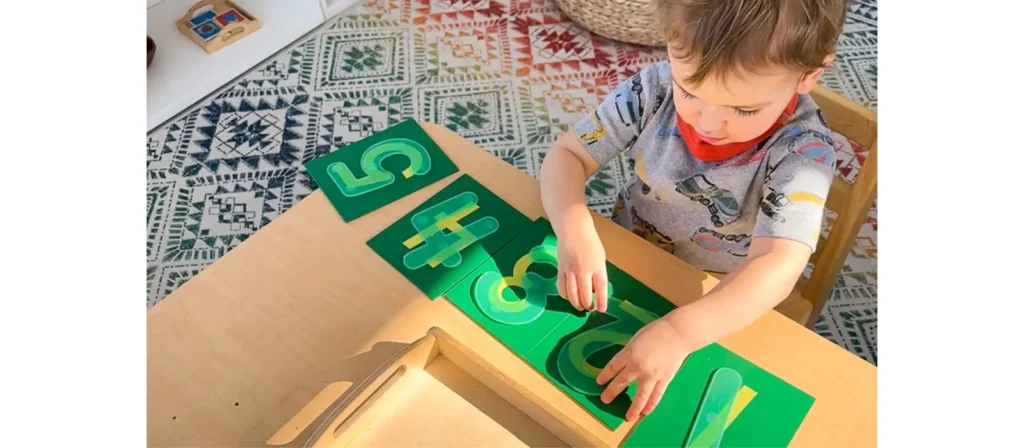
How Do Montessori Sandpaper Numbers Work?
The Montessori Sandpaper Numbers lesson introduces children to the written symbols for numbers through touch and repetition. It bridges the gap between sensorial experience and abstract math by combining three elements: sight, sound, and movement. The child traces each numeral cut from textured sandpaper while saying its name aloud. This multisensory experience helps build a concrete connection between what the child sees, feels, and hears. Over time, this tactile familiarity transforms into effortless recognition and writing of numerals.
Direct Aim
- To introduce the written symbols for numbers 0–9.
- To help the child associate each Montessori number with its spoken name.
- To develop a tactile and visual understanding of sandpaper numerals Montessori.
Indirect Aim
- To prepare the hand for writing through controlled finger movement.
- To refine hand–eye coordination and ince motor becerileri.
- To support later work with Montessori number beads, Montessori number roll paper, and other numbers Montessori materials.
- To nurture concentration, order, and independence.
Points of Interest
- The contrast between the rough sandpaper numeral and the smooth green board.
- The unique texture and feeling of each number’s shape.
- The sound of fingers softly gliding across the sandpaper.
- The consistent color, size, and order of the number boards.
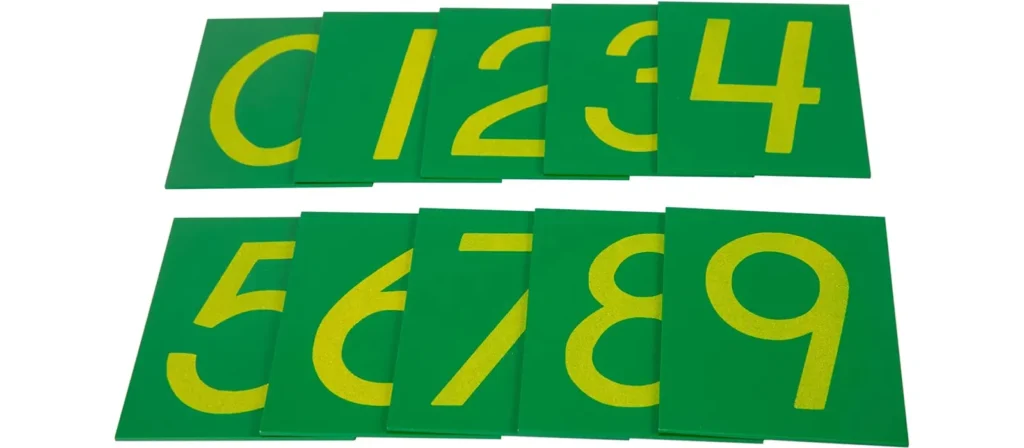
Gerekli Malzemeler
- A full set of Montessori Sandpaper Numbers (0–9), each mounted on a green wooden board.
- A work mat or child-sized table.
- A small tray or box to hold the numeral cards.
- Optional: Montessori number beads or Montessori number roll paper for later extensions.
Yaş Aralığı
Typically presented to children aged 3 to 4 years, depending on readiness for number recognition and fine motor coordination.
The Montessori Sandpaper Numbers lesson is not about memorizing digits but about experiencing them through touch, sight, and sound. This sensory-based method transforms number symbols into living, memorable impressions, creating the foundation for all later numbers Montessori work.
Montessori Sandpaper Numbers Presentation
Step 1: Preparation
Before beginning, make sure the sandpaper numerals Montessori cards are clean and neatly arranged in order from 0 to 9. Choose a quiet area with no distractions and spread a work mat on the floor or use a low table. Invite the child to join you, saying, “Would you like to feel some numbers with me today?” Sit beside the child so they can clearly observe your movements.
Step 2: Introducing the Material
Select three number cards to start, for example, 1, 2, and 3. Place them in front of the child from left to right. Move slowly and deliberately, showing respect for the material and for the child’s learning pace. Explain softly, “These are numbers. We can feel them with our fingers.”
Step 3: Naming and Tracing
Pick up the first card and place it directly in front of the child. Point to the numeral and say, “This is number one.” Slowly trace the number with the index and middle fingers of your dominant hand, following the correct formation. After tracing, lift your hand and let the child try.
Encourage them to say the number’s name while tracing, helping them connect touch, sound, and symbol.
Repeat the same process with the next two numbers.
The presentation of Montessori Sandpaper Numbers follows a calm, structured, and deliberate sequence. The goal is to help the child experience each number symbol through repetition and touch while maintaining independence and focus. The teacher’s role is to demonstrate clearly, speak minimally, and allow the child to explore freely. This step-by-step process uses the classic Montessori Three-Period Lesson, ensuring that recognition, naming, and recall happen naturally and sequentially.
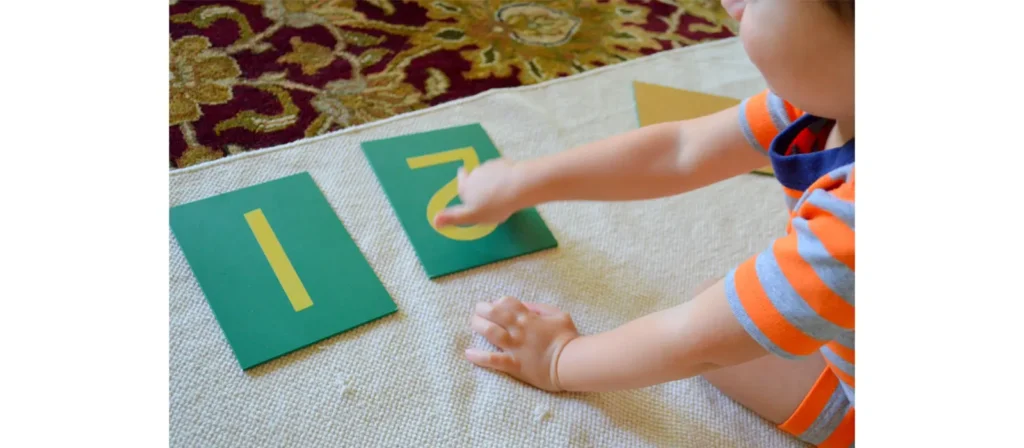
Step 4: The Three-Period Lesson
- First Period — Naming
You introduce each card one by one:
“This is one.” (trace)
“This is two.” (trace)
“This is three.” (trace)
Allow the child to repeat the words and trace after you. - Second Period — Recognition
Mix the cards and ask, “Can you show me number two?”
Then: “Can you show me number one?”
Change the order each time to reinforce recognition. - Third Period — Recall
Point to one card and ask, “What number is this?”
Pause and wait patiently for the child’s response. If they answer correctly, smile and nod silently; if not, gently reintroduce that card and repeat tracing.
The Three-Period Lesson helps the child move from hearing Ve seeing to knowing Ve remembering without feeling pressured.
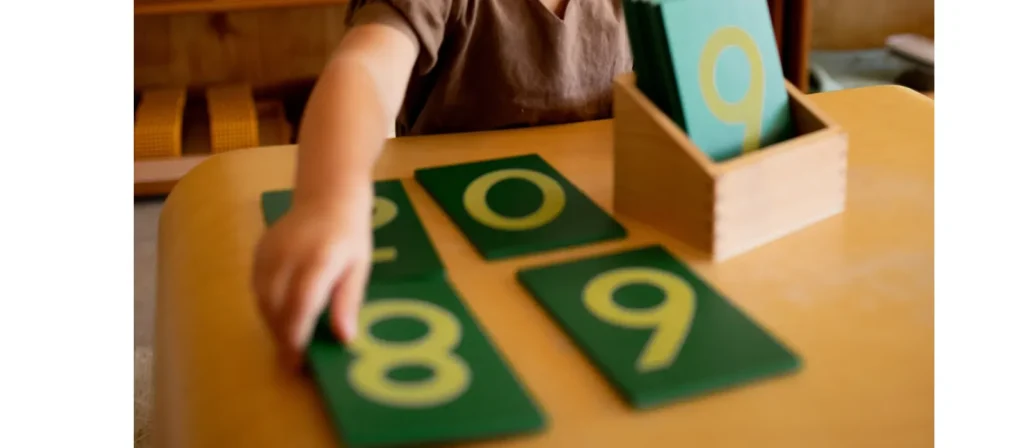
Step 5: Repetition and Mastery
Once the child confidently recognizes 1, 2, and 3, introduce the next set (4, 5, and 6) in a separate session. Continue gradually until all numerals from 0–9 are mastered. Always follow the child’s interest, as some may want to repeat the same cards many times before moving on.
Repetition is the essence of Montessori work: it strengthens memory and builds independence. The child should be free to take out the Montessori Sandpaper Numbers whenever they wish and practice tracing on their own.
Montessori Sandpaper Numbers Extensions
Once the child is familiar with the Montessori Sandpaper Numbers, you can begin introducing extensions to deepen their understanding of number relationships and to connect abstract symbols to concrete quantities. These extensions are a natural progression within the numbers Montessori curriculum and are designed to maintain the child’s interest while gradually increasing the challenge. Each extension continues to use touch, movement, and visual association to reinforce what has already been learned.
1. Matching Quantities to Symbols
After the child can confidently recognize and name numerals 0–9, invite them to match each sandpaper numeral Montessori card with real quantities. You can use small objects such as shells, beads, buttons, or even pieces from the Montessori number beads set.
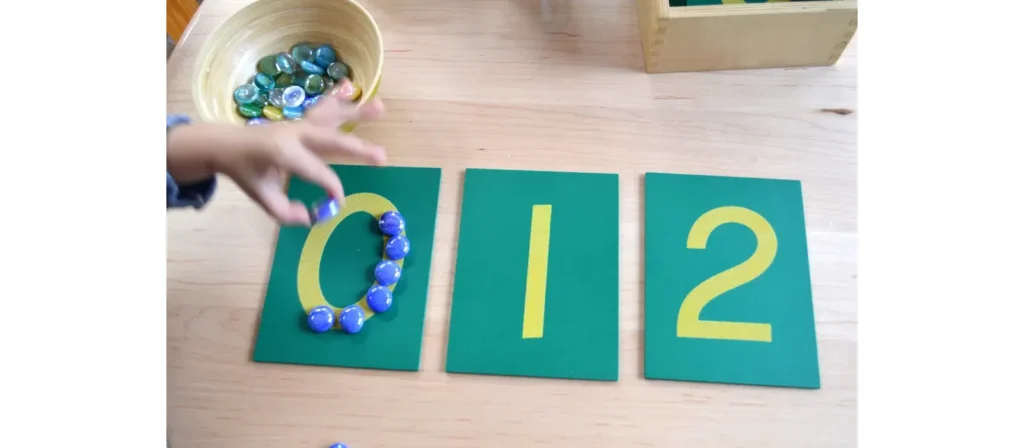
Adımlar:
- Lay out several sandpaper number cards in order on a mat.
- Present a basket of identical counting objects.
- Say, “Let’s put one bead next to number one, two beads next to number two…”
- Continue until each card has the correct number of objects.
- Encourage the child to count aloud as they place each object.
This activity links the symbol to the quantity and helps the child internalize the concept that each numeral represents a specific amount.
2. Sequencing and Number Order
Children naturally enjoy putting things in order. Provide them with mixed Montessori Sandpaper Numbers and invite them to arrange the cards from 0 to 9.
To make this more dynamic:
- Mix the cards and say, “Can you find what comes after 3?”
- Or remove a card and ask, “Which number is missing?”
This reinforces numerical sequencing and strengthens memory through repetition and discovery. For more advanced practice, you can pair this activity with Montessori number roll paper, letting the child write the sequence of numbers to extend from tactile to written expression.
3. Tracing in the Air or on a Tray
Encourage the child to “trace” the numbers in the air using large arm movements, or on a tray filled with sand, flour, or salt. These kinesthetic extensions give children freedom of movement and help them practice numeral formation before using pencils.
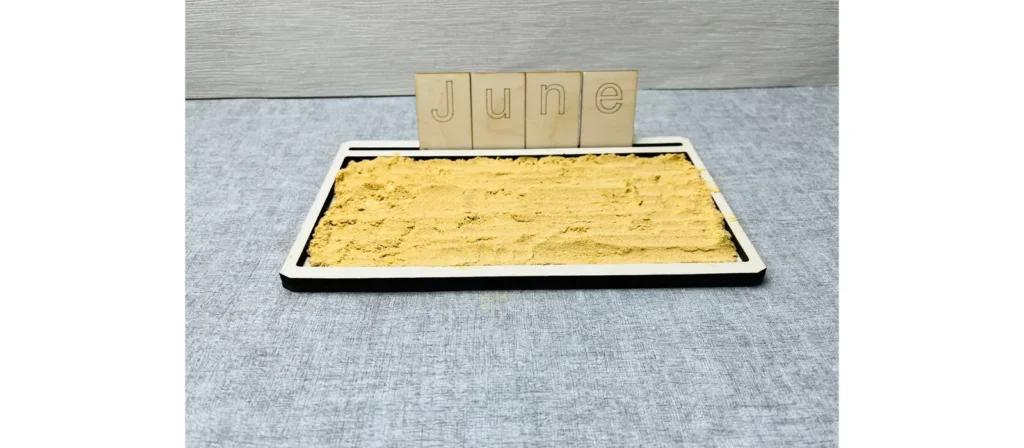
Örneğin:
- Trace the Montessori number 5 on a sand tray while saying “five.”
- Then match it with the corresponding sandpaper numbers Montessori card.
This transition from tactile tracing to free-hand motion refines coordination and prepares the hand for writing.
4. Pairing with Montessori Number Beads
The Montessori number beads are ideal for linking abstract numerals with physical quantities. Introduce one set at a time to maintain clarity.
Example activity:
- Place the sandpaper number 3 card on the mat.
- Present a chain of three beads.
- Say, “This is three. Let’s count them together.”
- Allow the child to touch and count each bead while repeating the word “three.”
As the child progresses, you can introduce bead bars for 4 through 9, creating a visual pattern that highlights the relationships between quantities.
5. Writing and Number Roll Paper
Once tracing and recognition are mastered, children can begin practicing on Montessori number roll paper. This long roll allows children to freely write and repeat numbers as far as they wish.
- Begin by placing the sandpaper numerals Montessori cards nearby as visual guides.
- Invite the child to write each number they have learned.
- Encourage them to roll the paper forward to continue counting in sequence.
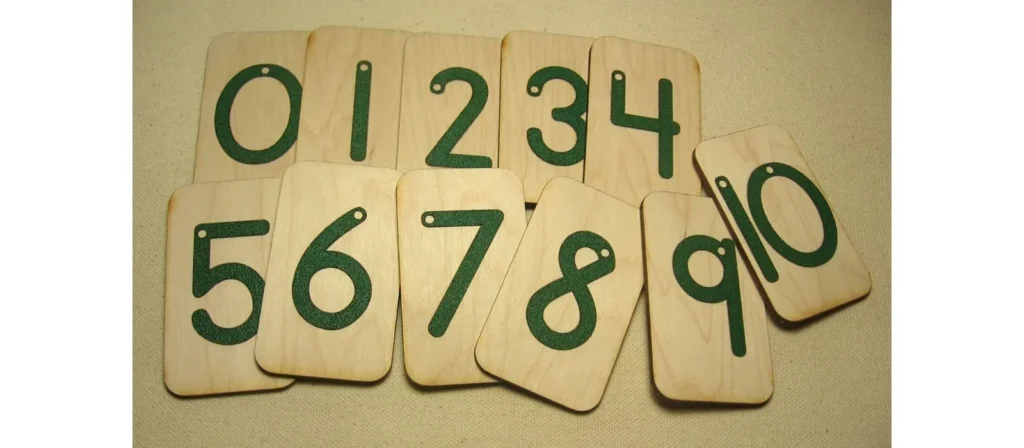
This activity naturally leads into understanding tens and the decimal system as they begin to write higher numbers.
6. Memory and Movement Games
To keep engagement high, introduce small games:
- Place several number cards around the room and ask the child to find a specific number you call out.
- Hide the Montessori sandpaper numbers under a cloth and invite the child to identify them by touch alone.
- For older children, mix cards and quantities to play matching games or “missing number” challenges.
Games like these strengthen recall and confidence while reinforcing tactile and visual association.
7. Group or Peer Work
Once a child becomes comfortable working independently, they can explore with a classmate. One child selects a sandpaper number Montessori card, and the other finds the corresponding bead quantity or writes the number on number roll paper. Collaborative work promotes language development, social skills, and gentle peer teaching, core aspects of Montessori learning.
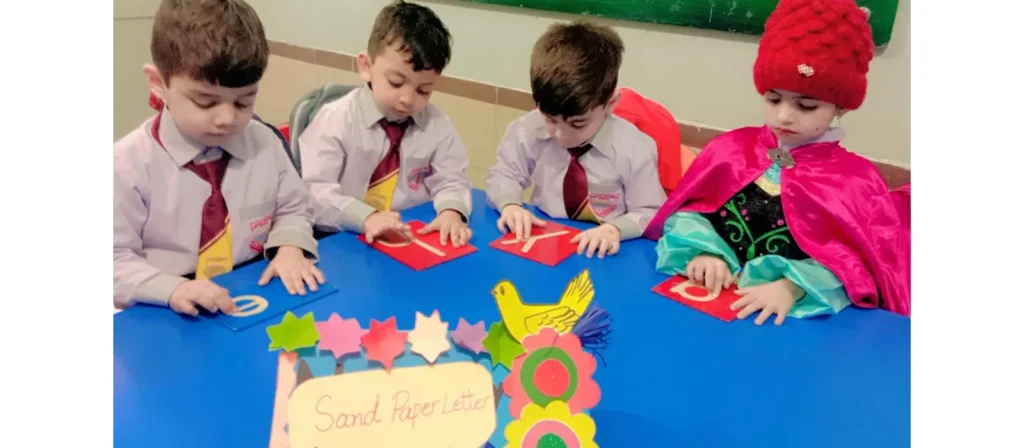
8. Integration with Everyday Life
Encourage families and teachers to connect the sandpaper numbers to real-world experiences:
- Counting apples or utensils at snack time.
- Recognizing house numbers during walks.
- Labeling drawers, books, or plants with numerals.
These everyday applications transform Montessori Sandpaper Numbers from isolated classroom materials into part of a child’s lived mathematical experience.
Through these thoughtful extensions, Montessori Sandpaper Numbers evolve from a simple tactile tool into a complete foundation for mathematical understanding. Each activity builds upon the last, guiding the child from feeling and seeing numbers to writing and using them independently.
Çözüm
Through careful presentation and meaningful extensions, sandpaper numerals Montessori lessons lead children from symbol recognition to genuine comprehension. As they progress to using Montessori number beads, Montessori number roll paper, and other number materials, they begin to see that numbers are not static marks on a page but dynamic representations of the world around them. Every quantity, every object, every measurement becomes an opportunity to explore the mathematical order that governs everyday life.
They remind us that learning starts with the senses, that touch, movement, and sound are as vital to the mind as words and logic. Whether a child is tracing their first “1” or writing a sequence on roll paper, each small movement builds confidence, precision, and curiosity. When presented with patience and respect, these lessons nurture not just mathematical ability but also the independence, concentration, and joy that define the Montessori child.

